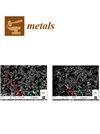Investigation on the Solidification Structure of Q355 in 475 mm Extra-Thick Slabs Adopting Cellular Automaton-Finite Element Model
IF 2.5
3区 材料科学
Q3 MATERIALS SCIENCE, MULTIDISCIPLINARY
引用次数: 0
Abstract
The solidification structure characteristics are decisive for the production of extra-thick slabs. This study developed a solidification heat transfer model and a cellular automaton–finite element coupled model to investigate the solidification behavior and structure characteristics of a 475 mm extra-thick slab. The models were applied under various continuous casting process parameters and different alloy element content. The simulation results reveal that casting speed has the most significant effect on the solidification behavior of extra-thick slabs, surpassing the impact of specific water flow and superheat. The solidification structure characteristics of the 475 mm extra-thick slabs were investigated under various conditions. The findings indicate that at higher casting speeds and superheats, the average grain size increases and the grain number decreases. The average grain size initially decreases and then increases with the rise in specific water flow, reaching its minimum at approximately 0.17 L·kg−1. Additionally, the average grain radius first decreases and then slightly increases with an increase in carbon content, achieving the minimum value of about 0.17% carbon. Compared with carbon and manganese, silicon has a greater impact on the solidification structure of ultra-thick slabs, and a moderate increase in silicon content can effectively refine the grain size. This study provides a theoretical foundation for understanding the changes in solidification structure characteristics and optimizing continuous casting process parameters for 475 mm extra-thick slabs.采用蜂窝自动机-有限元模型研究 475 毫米超厚板中 Q355 的凝固结构
凝固结构特征对超厚板坯的生产起着决定性作用。本研究建立了凝固传热模型和单元自动机-有限元耦合模型,以研究 475 毫米超厚板坯的凝固行为和结构特征。模型应用于不同连铸工艺参数和不同合金元素含量下。模拟结果表明,铸造速度对超厚板坯凝固行为的影响最大,超过了比水流量和过热度的影响。研究了 475 毫米超厚板坯在不同条件下的凝固结构特征。研究结果表明,在较高的浇铸速度和过热度下,平均晶粒尺寸增大,晶粒数目减少。平均晶粒尺寸最初减小,然后随着比水流量的增加而增大,在大约 0.17 L-kg-1 时达到最小值。此外,随着碳含量的增加,平均晶粒半径先减小后略微增大,在碳含量约为 0.17% 时达到最小值。与碳和锰相比,硅对超厚板坯凝固结构的影响更大,适度增加硅含量可有效细化晶粒尺寸。这项研究为了解 475 毫米超厚板坯凝固结构特征的变化和优化连铸工艺参数提供了理论基础。
本文章由计算机程序翻译,如有差异,请以英文原文为准。
求助全文
约1分钟内获得全文
求助全文
来源期刊

Metals
MATERIALS SCIENCE, MULTIDISCIPLINARY-METALLURGY & METALLURGICAL ENGINEERING
CiteScore
4.90
自引率
13.80%
发文量
1832
审稿时长
1.5 months
期刊介绍:
Metals (ISSN 2075-4701) is an open access journal of related scientific research and technology development. It publishes reviews, regular research papers (articles) and short communications. Our aim is to encourage scientists to publish their experimental and theoretical results in as much detail as possible. Therefore, there is no restriction on the length of the papers. The full experimental details must be provided so that the results can be reproduced. Metals provides a forum for publishing papers which advance the in-depth understanding of the relationship between the structure, the properties or the functions of all kinds of metals.
 求助内容:
求助内容: 应助结果提醒方式:
应助结果提醒方式:


